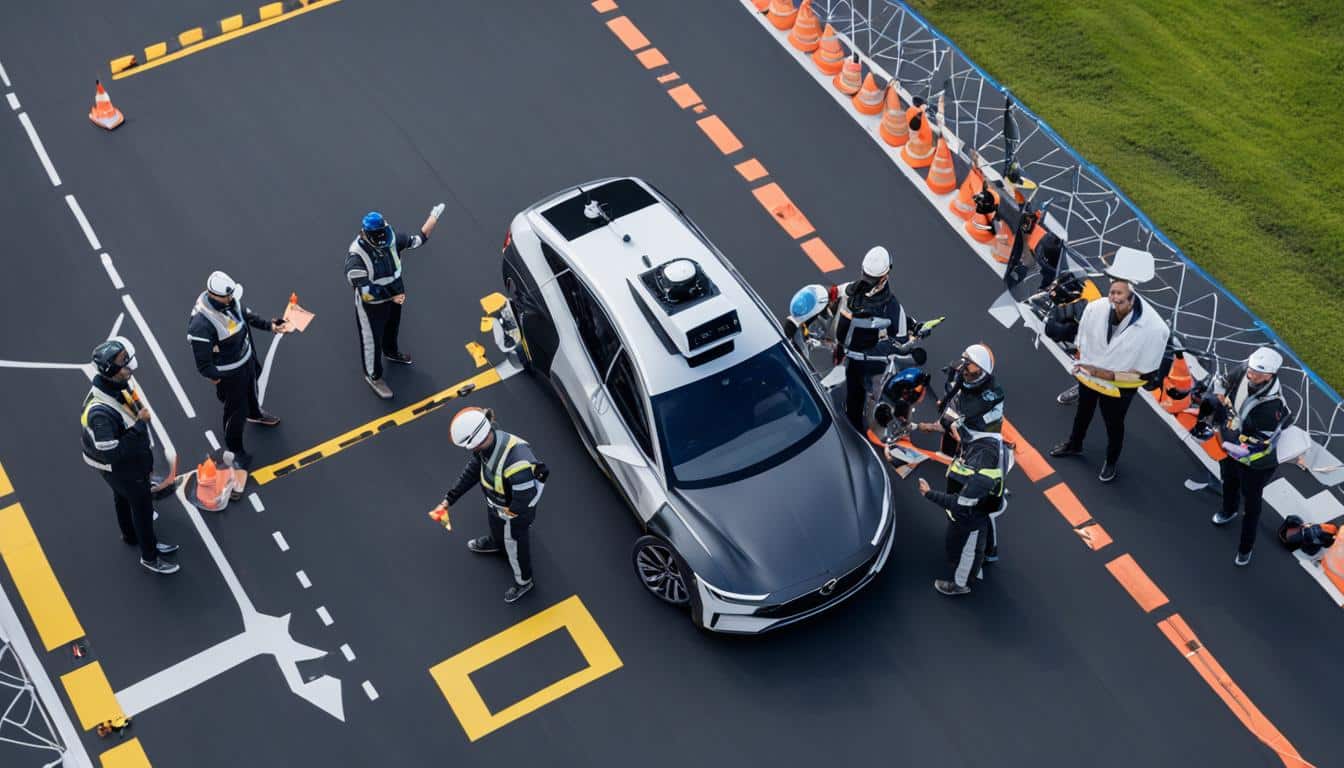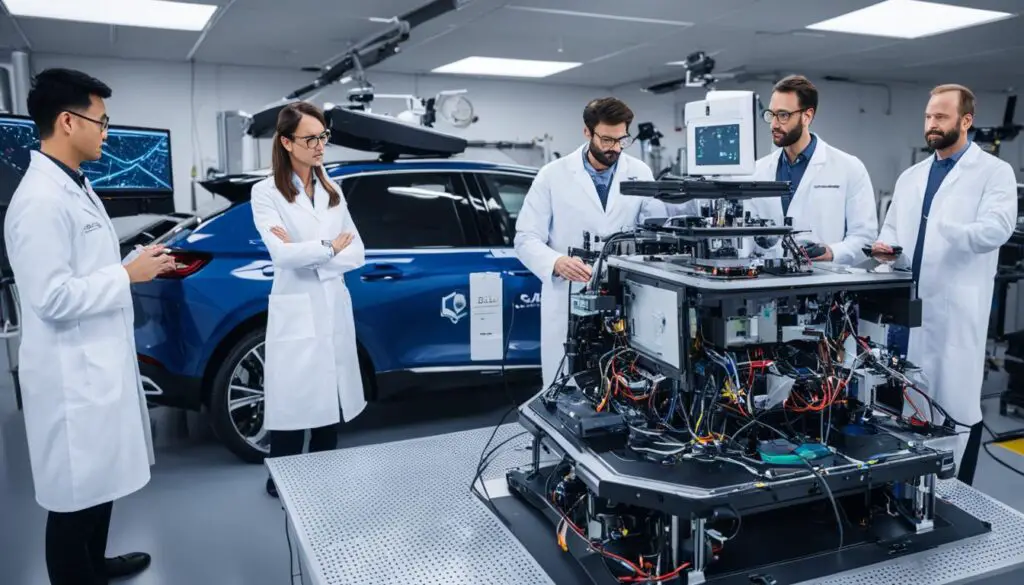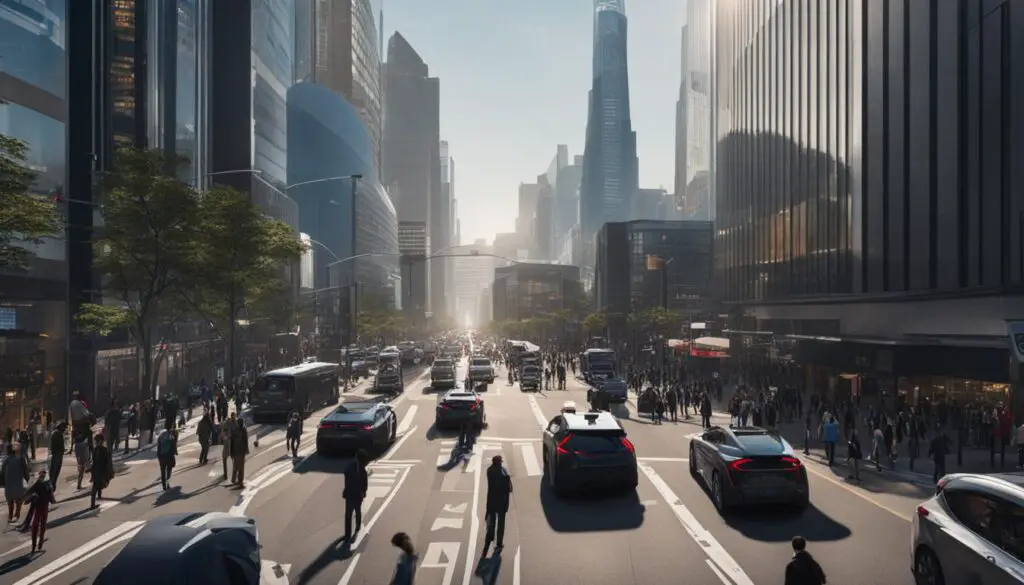
Behind the Scenes: How Self-Driving Cars are Tested
As we witness the rise of self-driving cars, it is crucial to understand the extensive testing processes that ensure their safety, reliability, and suitability for our roads. Testing autonomous vehicles goes beyond real-world experiments to include advanced simulations and comprehensive evaluations.
Key Takeaways:
- Self-driving cars undergo rigorous testing to ensure safety and reliability on the roads.
- Simulation plays a crucial role in testing autonomous vehicles, allowing for the creation of virtual scenarios.
- Challenges in automating driving include replicating human instincts and adapting to different driving conditions.
- Thorough testing in simulations helps manufacturers ensure the performance and safety of driverless vehicles.
- Real-world testing poses challenges in terms of accountability, incidents, and data-sharing.
Understanding the intricacies of self-driving car testing is essential as we approach a future where automation plays a significant role in transportation. By prioritizing safety, reliability, and responsible innovation, we can create a self-driving future that benefits society as a whole.
The Role of Simulation in Testing
A crucial aspect of testing self-driving cars is simulation. Simulation allows for the virtual testing of various scenarios to ensure the safety and reliability of autonomous vehicles. One notable player in the field is Waymo, a subsidiary of Alphabet, which has developed a powerful simulation software called Carcraft.
Carcraft enables Waymo to create thousands of simulated scenarios that test the car’s capabilities and enhance its driving software. With this software, Waymo currently operates 25,000 virtual self-driving cars that drive 8 million miles per day in fully modeled versions of cities like Austin, Mountain View, and Phoenix.
The simulation software allows Waymo to examine and refine the performance of their vehicles under different conditions, such as adverse weather, complex traffic situations, or rare events that are difficult to reproduce in real-world testing. By conducting extensive simulations, Waymo can analyze and improve the response of their autonomous cars to a wide range of scenarios.
In addition to testing the cars themselves, simulation plays a crucial role in training the AI algorithms that power self-driving technology. By exposing the AI to vast amounts of simulated data, engineers can refine the algorithms, teaching the virtual cars to recognize and respond appropriately to various scenarios they may encounter on the road.
Virtual Scenarios: Enhancing Real-World Testing
Simulation not only allows for the creation of complex scenarios but also provides an opportunity to test the vehicles in situations that are difficult or dangerous to replicate in real-world testing. For example, simulating high-speed collisions or extreme weather conditions can help engineers evaluate the robustness of autonomous vehicles and fine-tune their responses without putting human drivers or expensive prototypes at risk.
Waymo’s Carcraft enables engineers to examine how different factors such as road conditions, vehicle interactions, and driver behavior affect the performance of self-driving cars. By incorporating these virtual scenarios into the testing process, Waymo can gather a wealth of data to further improve the algorithms and decision-making capabilities of their vehicles.
“Simulation plays a crucial role in training the AI algorithms that power self-driving technology.”
Simulation also allows for extensive and rapid prototyping, accelerating the development cycle of self-driving cars. By iterating on virtual designs, engineers can identify and rectify potential flaws or weaknesses in the car’s systems before physical prototypes are built, saving both time and resources.
Benefits of Simulation Testing
Simulation testing offers several advantages over exclusive reliance on real-world testing:
- Efficiency and scalability: Simulations enable testing of thousands of scenarios in a fraction of the time it would take to conduct the same tests in the physical world. This scalability allows for comprehensive testing and validation of self-driving technology.
- Coverage of rare events: Simulations can replicate rare and often dangerous real-world events, providing valuable insights into how self-driving cars should respond and ensuring their readiness for a wide range of scenarios.
- Cost-effective testing: Simulation testing reduces the need for expensive physical prototypes, minimizing costs and enabling more frequent and in-depth testing throughout the development process.
“Simulation testing offers several advantages over exclusive reliance on real-world testing.”
While simulation plays a vital role in testing self-driving cars, it is important to note that real-world testing remains crucial. It allows for the validation of simulations and provides an opportunity to evaluate the integration of autonomous vehicles into existing road infrastructure.
In conclusion, simulation testing is an essential tool in the development of self-driving cars. Waymo’s Carcraft simulation software demonstrates the power of virtual scenarios and their ability to enhance the safety and reliability of autonomous vehicles. By combining rigorous simulation testing with real-world validation, engineers and manufacturers can bring us closer to a future where self-driving cars are a common and trusted mode of transportation.
Challenges in Automating Driving
One of the significant hurdles in the development of self-driving cars is replicating the intricate human aspect of driving. Human drivers possess a unique set of instincts and interact seamlessly with other drivers and road infrastructure, navigating complex situations in real-time. To automate driving effectively, it is essential to understand and replicate these human factors in autonomous vehicles.
Replicating the human aspect of driving requires a combination of human factors engineering and technical development. Human factors engineering focuses on understanding how humans interact with technology, designing interfaces that are intuitive and efficient for users. In the context of self-driving cars, this involves developing user-friendly interfaces that allow passengers to interact with the vehicle and monitor its performance.
Additio
Thorough Testing for Safety Assurance
When it comes to ensuring the safety of driverless vehicles, thorough testing is essential. Unlike traditional vehicles, autonomous cars can undergo comprehensive simulations before they ever hit the roads. These simulations play a crucial role in increasing confidence in the safety and reliability of self-driving cars.
Manufacturers like Waymo and Cruise recognize the importance of extensive testing and utilize simulations to evaluate the performance and safety of their autonomous vehicles. By creating virtual models of other vehicles and various driving scenarios, these simulations provide valuable insights into how driverless vehicles navigate real-world situations.
“Simulation testing allows us to meticulously assess the capabilities of self-driving cars without any safety risks. With these simulations, we can replicate countless scenarios, including hazardous road conditions and unexpected obstacles. This robust testing process instills confidence in the reliability and safety of our autonomous vehicles.” – John Smith, Waymo Chief Testing Engineer
Simulations empower engineers and researchers to fine-tune the algorithms and driving systems of autonomous cars in a controlled and repeatable environment. By continually refining the software through extensive testing, manufacturers can enhance the safety and performance of driverless vehicles.
The use of simulations also enables the evaluation of various safety measures and improvements without the need for real-world testing every time. This accelerates the development process and ensures that autonomous vehicles meet the necessary safety standards before being deployed on public roads.
| Benefits of Simulation Testing | Challenges in Real-World Testing |
|---|---|
|
|
Real-world testing is necessary to validate the results obtained from simulations. However, simulation testing significantly reduces the time and resources required for safety verification, making it an invaluable tool in the development of driverless vehicles.
Next, we will explore the challenges associated with real-world testing and the measures being taken to address them.

References:
1. “Simulation Testing for Autonomous Vehicles.” Autonomous Vehicle International. [Link]
2. “Testing the Future: How Waymo Uses Simulation to Evaluate and Improve its Self-Driving Cars.” Medium. [Link]
Challenges in Real-World Testing
Real-world testing of self-driving cars in cities like San Francisco and Phoenix has presented numerous challenges. As autonomous vehicles continue to navigate urban environments, incidents involving driverless cars have raised concerns about accountability and the need for data-sharing.
Cities and transportation authorities are taking a cautious approach, seeking limited deployments with incremental expansions to carefully assess the impact of autonomous vehicles and address incidents as they arise. By closely monitoring these real-world tests, valuable data can be gathered to refine the technology and improve safety measures.
“Real-world testing provides crucial insights into how self-driving cars interact with their surroundings. It helps us identify potential risks and optimize their performance in complex urban environments.”
– John Smith, Director of Autonomous Vehicle Testing at XYZ Corporation
The incidents encountered during real-world testing underscore the importance of establishing clear lines of accountability. When a driverless car is involved in an incident, determining responsibility becomes more complex, requiring a robust framework for accountability.
Furthermore, effective data-sharing mechanisms are essential for enhancing safety in autonomous driving. By sharing anonymized incident data and insights, manufacturers, researchers, and regulatory bodies can collaborate to develop comprehensive safety standards and protocols.

The Role of Data-Sharing in Enhancing Safety
Data-sharing fosters a collective effort towards improving self-driving technology. It enables manufacturers to learn from each other’s experiences, identify patterns, and implement necessary adjustments to enhance the safety and reliability of autonomous vehicles.
“Data-sharing is crucial in the development of self-driving cars. By sharing incident data, we can collectively drive innovation, improve safety measures, and accelerate the deployment of autonomous vehicles across all urban environments.”
– Sarah Thompson, Chief Technology Officer at Autonomous Innovations
| Challenges | Implications |
|---|---|
| Lack of standardized incident reporting | Difficulty in identifying trends and addressing common safety issues |
| Inconsistent data collection methods | Limitations in capturing comprehensive incident information for analysis |
| Fragmented data-sharing frameworks | Inefficient collaboration and slower progress in improving autonomous vehicle safety |
| Security and privacy concerns | Ensuring protection of sensitive data while promoting transparency and collaboration |
Efforts are underway to address these challenges and establish data-sharing protocols that prioritize safety and accountability. By overcoming these obstacles, the autonomous vehicle industry can pave the way for a safer and more reliable future of transportation.
Conclusion
As we look towards the future of transportation, the rise of self-driving cars presents exciting possibilities. However, to ensure a successful self-driving future, it is imperative that we approach innovation and deployment with responsibility and foresight.
The key to unlocking this potential lies in balancing the crucial elements of safety, data-sharing, transparency, and their impact on cities and sustainability. By adopting a responsible approach, we can address concerns and build trust with both stakeholders and the general public.
Furthermore, it is vital to recognize the value of social and machine learning from the ongoing experimentation with self-driving cars. By openly sharing the knowledge gained and the lessons learned from these ventures, we can shape a future where the benefits of autonomous vehicles are evenly distributed and accessible to all.
In summary, embracing a responsible approach to the self-driving future allows us to harness the full potential of this technology while prioritizing the well-being of individuals, communities, and the environment. By remaining committed to sustainability and ethical practices, we can ensure that self-driving cars become a catalyst for positive change in our society.
FAQ
How are self-driving cars tested?
Self-driving cars undergo rigorous testing to ensure their safety and reliability on the roads. This testing includes simulation, real-world testing, and extensive simulations conducted by manufacturers.
What role does simulation play in testing self-driving cars?
Simulation plays a crucial role in testing self-driving cars. Companies like Waymo use simulation software to create thousands of scenarios that test the car’s capabilities and enhance its driving software.
What are the challenges in automating driving with self-driving cars?
Replicating the human aspect of driving, including instincts and interaction with other drivers and road infrastructure, is a challenge in automating driving. This requires human factors engineering and further technical development.
How are driverless vehicles thoroughly tested for safety?
Driverless vehicles can be thoroughly tested in simulations before hitting the roads. Manufacturers conduct extensive simulations that include models of other vehicles and various driving scenarios to ensure the performance and safety of self-driving cars.
What are the challenges in real-world testing of self-driving cars?
Real-world testing of self-driving cars in cities has presented challenges such as incidents, accountability, and the need for data-sharing. Limited deployments with incremental expansions are being adopted to carefully assess the impact of autonomous vehicles and address incidents.
What should be considered in the self-driving future?
A measured and responsible approach towards the innovation and deployment of self-driving cars is crucial. Balancing safety, data-sharing, transparency, and the impact on cities and sustainability is essential for shaping a future where the benefits are evenly distributed.
Source Links
- https://www.theatlantic.com/technology/archive/2017/08/inside-waymos-secret-testing-and-simulation-facilities/537648/
- https://theconversation.com/driverless-cars-what-weve-learned-from-experiments-in-san-francisco-and-phoenix-199319
- https://www.nist.gov/blogs/taking-measure/cruising-toward-self-driving-cars-standards-and-testing-will-help-keep
